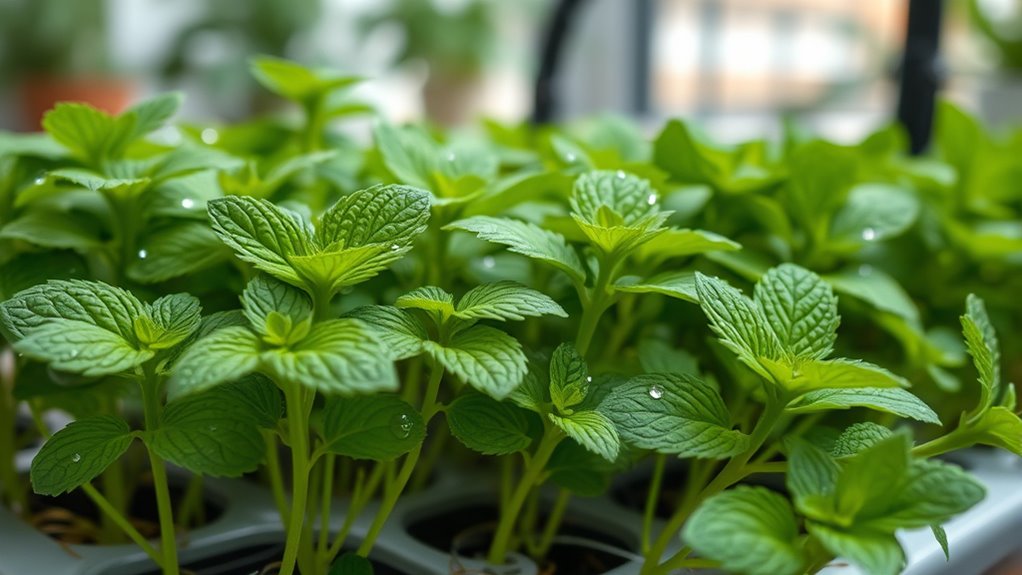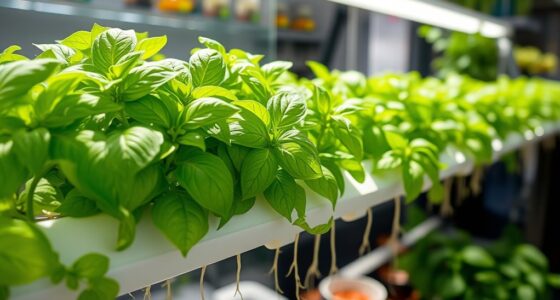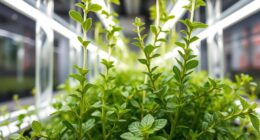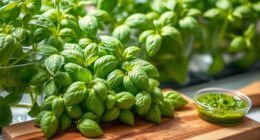To grow hydroponic mint successfully, you need to provide bright, indirect light and maintain proper nutrient levels with a balanced fertilizer. Keep your system clean, monitor pH and EC levels, and use filtered water to prevent pests and diseases. Regularly harvest leaves to promote growth, and make certain good airflow to avoid mold. If you follow these steps, you’ll enjoy healthy, flavorful herbs—there’s much more to explore about maximizing your mint’s potential.
Key Takeaways
- Maintain proper nutrient balance, pH (6.0–7.0), and regular water changes for healthy mint growth.
- Provide bright, indirect light or grow lights for 12–16 hours daily to promote vigorous, aromatic leaves.
- Keep the hydroponic system clean, monitor for pests, and ensure good airflow to prevent mold and disease.
- Regularly harvest mint leaves to encourage continuous growth and maximize flavor and freshness.
- Use pest prevention strategies like system sanitation, proper airflow, and vigilant monitoring to protect your mint plants.

Are you interested in growing fresh mint without soil? Hydroponic mint cultivation offers an efficient way to enjoy this aromatic herb year-round, all while minimizing pests and maximizing flavor. Since you’re growing mint in a soil-free environment, pest prevention becomes simpler, reducing the need for chemical treatments. Without soil, common pests like aphids and soil-borne fungi are less likely to invade your plants, but vigilant monitoring remains essential. Keeping your hydroponic system clean and maintaining proper nutrient balance helps prevent pest problems from arising in the first place. A balanced nutrient solution ensures your mint gets all the essential elements it needs to thrive, making it healthier and less susceptible to pests and diseases.
Growing mint hydroponically simplifies pest prevention and ensures healthy, flavorful herbs year-round.
To achieve this, you should regularly check your nutrient solution’s pH and electrical conductivity (EC). Mint prefers a slightly acidic to neutral pH, around 6.0 to 7.0, which helps facilitate nutrient uptake. When the nutrient balance is just right, your mint will grow lush, vibrant leaves with a strong aroma. Over- or under-fertilizing can weaken the plant’s defenses, making it more vulnerable to pests and diseases. It’s best to use a hydroponic-specific fertilizer that supplies a balanced mix of nitrogen, phosphorus, and potassium, along with trace minerals. Adjust your nutrient solution as needed based on plant response and growth stage, ensuring your mint always has what it needs to flourish.
Lighting is another critical factor. Mint loves bright, indirect light, which encourages healthy growth and strong flavor. If you’re growing indoors, consider using grow lights to supplement natural sunlight, keeping the light on for about 12-16 hours daily. Proper lighting, combined with maintaining an ideal nutrient balance, promotes vigorous growth and helps prevent pest infestations by keeping your plants healthy and resilient. Good airflow around your hydroponic system also contributes to pest prevention, as it discourages mold and fungal issues that can attract pests. Additionally, the use of appropriate lighting can enhance overall plant health by simulating natural conditions more effectively.
Water quality is equally important. Use clean, filtered water to prevent introducing pests or pathogens into your system. Regularly change and monitor your nutrient solution to avoid imbalances that could weaken your plants. In addition, inspect your mint regularly for signs of pests or disease, catching any issues early before they spread. Maintaining a sanitary system, keeping the environment clean, and ensuring your mint receives the right nutrients and light will result in a robust, flavorful crop. Growing hydroponic mint is a straightforward process when you prioritize pest prevention and nutrient balance, leading to fresh, fragrant leaves that are perfect for culinary uses or tea.
Frequently Asked Questions
What Are Common Pests That Affect Hydroponic Mint?
You’ll want to watch out for pests like aphids, spider mites, and whiteflies that can affect your hydroponic mint. To manage these, implement pest management strategies early and consider organic controls like neem oil or insecticidal soap. Regularly inspect your plants, keep humidity levels balanced, and remove affected leaves promptly. These steps help keep your mint healthy and pest-free without resorting to harsh chemicals.
How Do I Prevent Mold in My Hydroponic Mint System?
To prevent mold in your hydroponic mint system, focus on fungus prevention by maintaining proper humidity control. Keep humidity levels below 60% to inhibit mold growth, and guarantee good air circulation around your plants. Regularly clean and disinfect your system components, and avoid overwatering. By managing humidity and practicing good hygiene, you create an environment that discourages mold and promotes healthy mint growth.
Can Hydroponic Mint Survive Winter Indoors?
Yes, your hydroponic mint can survive winter indoors. To guarantee its survival, provide adequate indoor lighting, like grow lights, to mimic sunlight. Keep the temperature controlled between 65-75°F, avoiding cold drafts or heat sources. Consistent lighting and temperature help your mint thrive through winter. Regularly check the system for mold and maintain proper airflow, so your mint stays healthy and lush all season long.
What Are the Signs of Nutrient Deficiency in Hydroponic Mint?
You’ll notice nutrient deficiency in your hydroponic mint through leaf discoloration, like yellowing or pale leaves, and uneven growth. A nutrient imbalance can cause these symptoms, so check your nutrient levels regularly. If the leaves turn brown or develop spots, it’s a sign you need to modify your fertilizer. Keep an eye on the overall plant health, and guarantee your nutrient solution remains balanced to promote lush, healthy mint.
How Do I Extend the Harvest Period for Hydroponic Mint?
Did you know that proper harvest timing can extend your mint’s yield by up to 30%? To do this, you should regularly prune your hydroponic mint, focusing on cutting back stems just above a set of leaves. Using effective pruning techniques encourages new growth and prolongs harvest periods. Keep harvesting new mint shoots early, and your plant will continue producing fresh, fragrant leaves longer.
Conclusion
Think of your hydroponic mint as a tiny green domain, thriving under your care like a loyal garden guardian. With each careful step you take—watering, harvesting, and nurturing—you’re tending to a fragrant treasure that blooms endlessly. Remember, your patience and attention turn this small herb into a lush, vibrant sphere of flavor and freshness. Keep tending, and your mint kingdom will flourish, offering you a never-ending bounty of zest and serenity.








